In this issue
Feature
Swift Parrot habitat rehabilitation: work begins!
-Lorraine Hawdon
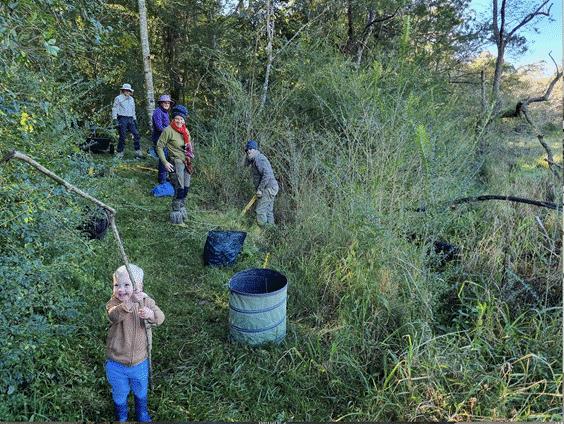
Rehabilitation Begins – BEFORE
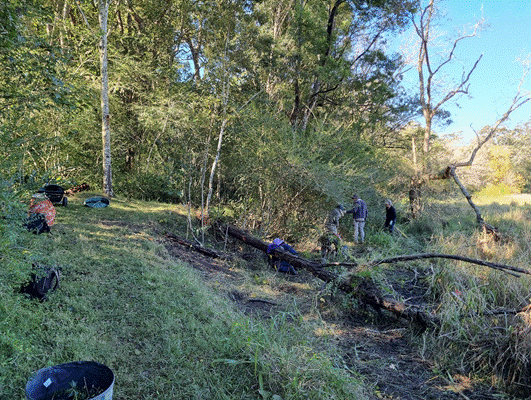
AFTER
“We all know the importance of planting trees and managing weeds, but winning this grant demonstrates the value of our work and makes sure that we actually do it!” -Guy Dutson, Ecologist.
Excitement is growing at Narara Ecovillage over our grant of $17,503 to create winter feeding habitat for the critically endangered Swift Parrot. We would like to acknowledge the receipt of this grant from Local Land Services. *
Swift Parrots migrate from Tasmania to the mainland (including the Central Coast) each Autumn and Winter. One of the key species providing winter food for Swift Parrots is the Swamp Mahogany (Eucalyptus robusta) and the border of Narara Ecovillage’s floodplain is a great place to grow this tree.
We will also plant Casuarina, Acacia and Gahnia to provide a nurturing habitat for Swamp Mahoganies and other wildlife. We are committing to maintaining the trees for at least 20 years until the new trees have shaded-out the weeds.
Our very active Bush Regeneration group recently began rehabilitating the area for the project. They started by removing the woody weeds from the eastern edge of the wetlands ready for planting. You can see the difference they have made in just a few hours (see photos above). It looks a little bare now, but they will be monitoring for growth of both native and weedy plants as well as planting the area with natives in the near future.
The most exciting news for Network News readers is that there will be opportunities for you to be involved in this exciting initiative! We will be inviting NELN members and members of the public to participate in three hands-on weeding and planting workshops combined with educational presentations and practical techniques of weed removal and planting. The Community Environment Network (CEN) will provide professional bush regenerators to assist throughout the project, including running the workshops.
Stay tuned for upcoming workshop dates:
- in future editions of Network News OR
- On our facebook page: Narara Ecovillage Community OR
- Our Website: Narara Ecovillage.
* GS01665 Narara Ecovillage Narara Ck Stage 1 is supported by Local Land Services through funding from NSW Treasury
The marked area indicates the land to be regenerated and planted with Swamp Mahoganies.
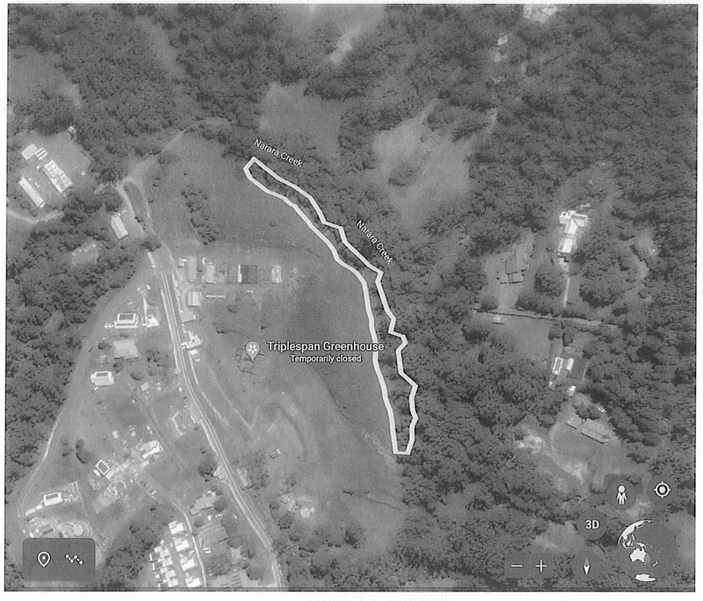
Reader feedback: Birdstrike! Taking care of stunned birds
Following last issue’s feature story, ‘Birdstrike!’, reader Karen D writes:
I find that a drop of Bach’s ‘Rescue Remedy’ works wonders for stunned birds.
I also protect recovering birds (in situ) with a cardboard box propped up at one end. This provides a dark, safe environment for the bird till it feels strong enough to fly away.
I have also done this for a magpie baby that fell from a nest. The parents came and fed it till it was old enough to fly – then later brought its siblings to meet me … How cool is that !!!
Events
Open Day at Narara Ecovillage – Sunday 31st July
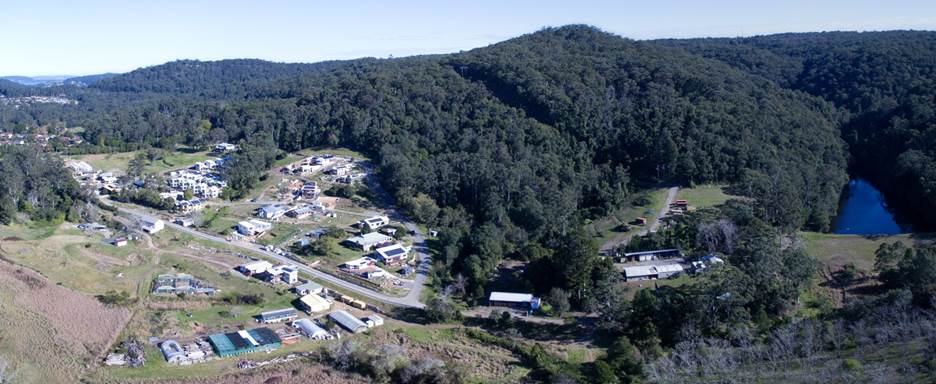
Aerial photo showing Stage 1, nursery areas, Farm Square and part of the rural lots – it’s a large area!
- Where Narara Ecovillage, Gugandi Road Narara NSW 2250
- When Sunday 31st July, from 10.30am
- Cost from $15 pp, kids free
- More details and tickets https://july-2022-open-day.lilregie.com/
Our Open Days are expanding
We’re adding to the wonderful 90 minute mornings where you can grab coffee and muffins, get an overview of village history by ecovillage founder Lyndall Parris and enjoy a guided tour around the village pointing out the aspects of sustainability in housing, food production, community governance and of course fun!
Sunday’s full program:
- Talk & village Tour: 10:30am–12:00pm
- Lunch – Scrummy Winter Soup made from local and organic ingredients & homemade bread: 12:30–2:00pm
- Earth Care Game Talk & Play: 2:00–3:30pm
A caution – Due to Covid we may need to pivot online, which is no problem! We will notify you by email if you’re registered, and we ask that you please keep an eye on our Facebook page for other updates.
The tours
Every talk/tour and tour guide is different as the village is in constant evolution.
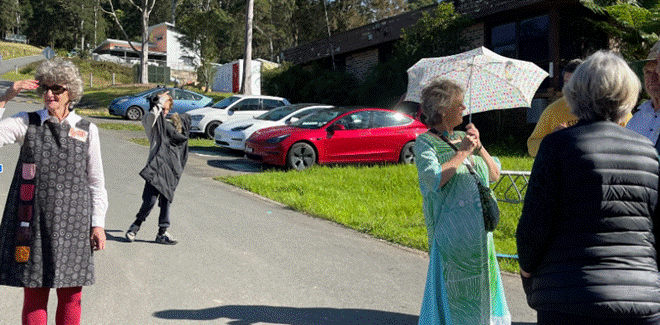
Lyndall Parris & Sharyn W prepare to lead tours of the village.
Note our groundbreaking community battery and the electric vehicle charging station in the background.

Walking on the common gardens between houses in Stage 1
The game
In the afternoon, we’ll be hearing from long term environmental educator Lisa Wriley, who encourages anyone who is a leader, an educator, parent, grandparent or eco-citizen to come & see how the Earthcare Game can generate conversations and actions!
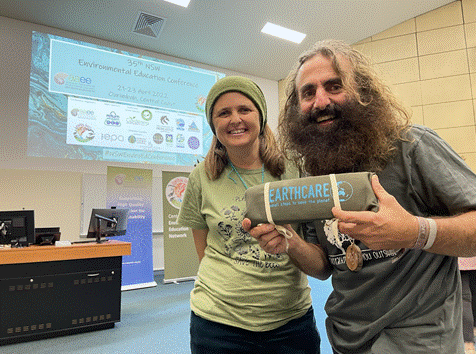
Lisa with Costa Georgiadis – photo Tanya Mottl
Testimonials following our last online open day (in January):
“I liked meeting the community and the sense of careful planning mixed with spontaneity. There was also a sense of consciously shared leadership and this was amongst newer and older members. I thought it was quite a comprehensive introduction in conjunction with the FAQs online. I think having different ages present was also a happy intro to your community vibe. Another beautiful part was that the land, the plants, garden were all present in the intro – a living ecology.”
More details and tickets https://july-2022-open-day.lilregie.com/
Founder’s Books available to purchase
Lyndall Parris’s s book Creating an Ecovillage is for sale, so you can dive deep into her journey, from doing an early Ecovillage Design Education course at Crystal Waters to visiting ecovillages globally to get ideas and inspiration, and ultimately founding Narara Ecovillage. Testimony to having a dream and seeing it unfold!

Katrina ready to read about how the village was founded
Experience Living at Narara Ecovillage Fri Sept 30- Sun Oct 2
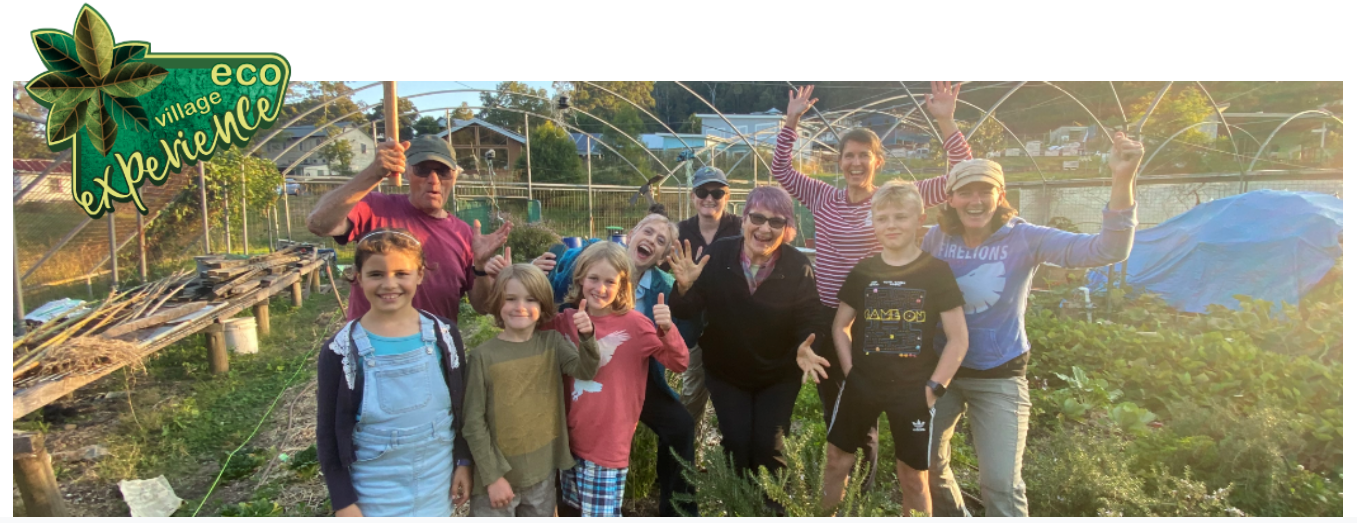

Would you like to experience life in a dynamic, inter-generational, village eco-community, with effective self-governance, where neighbours are strongly connected through a shared aim? Our second Ecovillage Experience Weekend is in evolution based on the fabulous inaugural event in March.
Once again, you are invited to stay at village homes, and experience a stimulating program of workshops and activities led by members of the ecovillage. These include Deep Ecology with well known rainforest activist, John Seed, visiting some of our beautiful Eco homes- including hemp, straw bale, mudbrick & tiny homes, as well as an earthship, and joining in outdoor working bees, campfire community dinners and story-telling.
Children are welcome too, and a parallel program of kids activities will be offered once again.
Read more about the event, and how to register & take advantage of the early bird discount
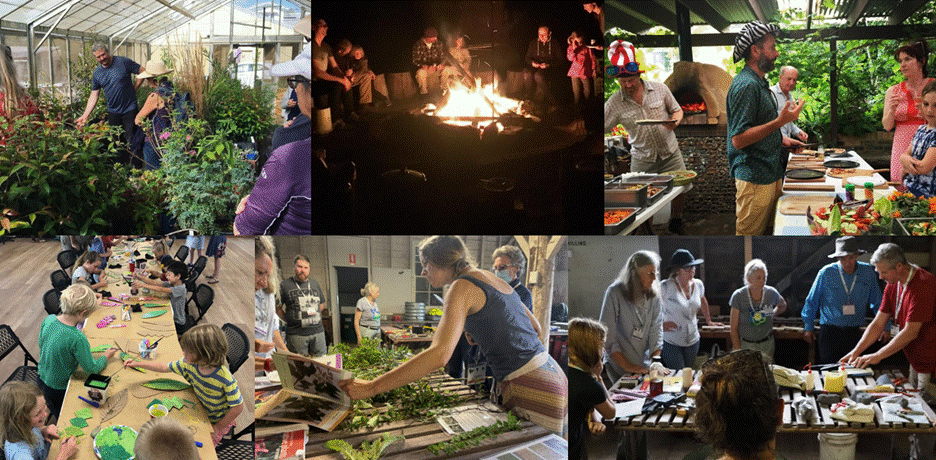

Village News
Winter Solstice Celebration

“As a culture, we deny the winter and decay which is an inevitable part of life. And we miss the point that everywhere you look, life grows out of death and light comes forth out of dark.”
– Morgan Wainwright
Village members and visitors of all ages came together on the night of Saturday 25 June to celebrate the Winter Solstice. We were greeted by colourful lanterns, flickering flames and smiling faces as we left the village centre to weave our way through the streets.
The lantern walk ended at the campground near the dam, where each attendee was invited to take part in a small ceremony: firstly, to burn and leave behind that which was no longer needed in the trio of fires warming the dam wall; secondly, to stake their highest intention for the year to come in the ground using painted wooden stakes.
As a culture, we deny the winter and decay which is an inevitable part of life. And we miss the point that everywhere you look, life grows out of death and light comes forth out of dark.
Meals were had, laughter was shared as we honoured the longest night of the year.
Until the longest day of the year arrives, enjoy this part of the cycle.
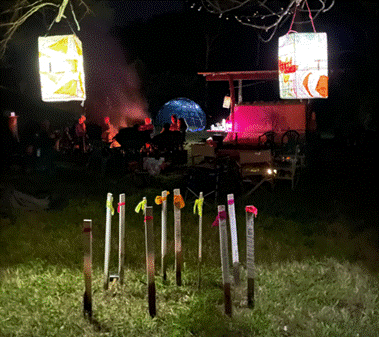
Photos: Tanya M
Frogs are going Off!!
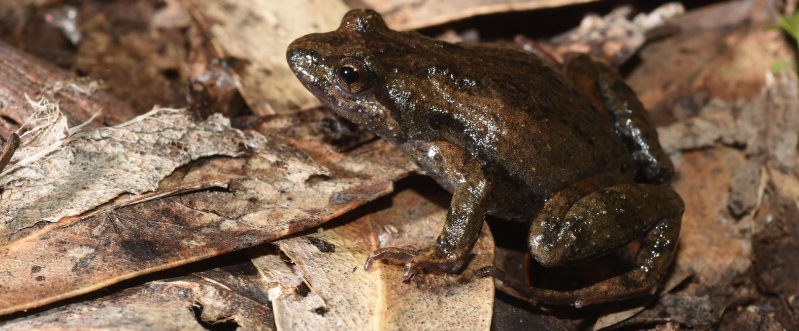
Crinia signifera. Photo: Jodi Rowley
-Lorraine Hawdon
Even though it is winter, and many frogs are resting in reeds and rushes next to ponds and creeks, some species are calling VERY loudly to show their love for the rain and each other! One of the most common species is the Common Eastern Froglet (Crinia signifera) which is shown in the photo from the Australian Museum. We’ve been recording plenty of calls from this little guy here at Narara Ecovillage. Read more about this very active and noisy little creature here: https://www.frogid.net.au/frogs/crinia-signifera.
Remember that it is important that we all keep recording and submitting calls to The Australian Museum so they can continue monitoring our frog populations throughout Australia. If you haven’t downloaded the app, it’s very easy to use & highly recommended! https://www.frogid.net.au/about-frogid
Just a gentle reminder: please do not pick up or handle frogs in any way, they are susceptible to the Chytrid fungus disease which can be fatal to frogs.
Nature, peace, and the village buzz

Pumpkin from the garden
-Rod
It is our third stay for a few weeks in Narara Ecovillage. First one was during summer, with plenty of sunny weather, beach and bushwalks, tropical humidity and cold showers. A bit of autumn in the middle with mild weather and now winter time. We make our way on the train for a few hours to avoid driving. Even though it took a bit longer with train strikes and changes, it was a nice and scenic ride, relaxing and quiet compared to the usual stresses of using a car: we always enjoy it. Half way walking to the village we stopped for a few minutes and a kind villager pulled over to give us a quick lift. It is barely a few minutes drive but we always enjoy a chat and a lift up the hill to the house.
On this winter Thursday afternoon the village is quiet. After a week of rain we can still hear little streams here and there. We don’t see anyone on the street at first – it feels as if everyone still expects the rain to continue, so it is not worth the trouble going out. The forecast for the week is promising though, and more sun is always great – with plenty of solar panels on every house providing free electricity and a top up of the community battery. The beautiful and ancient oak trees are still hanging onto their last brown leaves, providing colour to those who haven’t caught their autumn display.
At our first dinner in the house we sit at the table in silence for a few minutes. Coming from Sydney it is striking how much artificial noise there is in the city: cars, apartment doors, trains, shopping centre air-con, sirens and, of course, that guy on his motorcycle doing rounds through the suburb. We never thought much about it until now. We are enjoying our dinner listening to frogs and crickets; it feels as if we can finally stop processing those city sounds and just relax. Almost every morning we hear and see black cockatoos, eastern rosellas, butcher birds, magpies. We think there are ducks nesting nearby, as we could hear them too, and saw a pair high up the eucalypt tree (have you ever seen a duck in a tree?). Geese are honking far away on their daily walk, magpie larks are a common visitor right at the door checking for spiders, there is a brush turkey patrol in the evening and kookaburras are having a laugh. The goings of nature are so relaxing and entertaining.
Perhaps another great thing about the village is that there is always something happening and plenty of activities to choose from. Chickens need looking after in exchange for fresh eggs, a delivery arrives to the neighbours who need a hand, a friend is building a house and de-nailing of recycled hardwood provides a good couple of hours of exercise followed by a relaxing hot sauna. The local economy is buzzing as well, someone’s friend brings over extra citrus from a good crop this year (and more on the way). The recently and beautifully renovated community food buying space has delicious local organic olives, the most tasty local honey, and a taster pack of cumquats, lemons and limes is there too (together with 350+ other grocery items!). The localisation is fantastic: less need to run to the shops and the more local tasty everything. Oh, and there is a travelling musicians’ performance on one of the nights, spontaneous dinners with friends, great coffee and lunches at the coffee cart. We rarely feel the need to check the phones, the TV is never on, we might need to turn it on one time to watch that DVD on sustainable house designs, but then we have so many great books and magazines on the topic from the community library a 2 minute walk away that we might just hold off for a bit.
After a few days in the village the way of living in suburban Sydney is slowly waning into the background. Now there are more smiles, casual chats and friendliness. Walking down to the Village Hall provides beautiful views over the evening sky (especially beautiful today with strokes of darker blue, light grey and overripe raspberry across). The sun has already set, but I can hear voices and laughs coming up from the distance. I first think that kids are enjoying the last play for today at the playground or, perhaps, it is coming from the Village Hall where a fabulous dinner prepared by kids is getting ready to be served. It is a great feeling to hear the village, alive with a slight evening buzz and everything suddenly feels right.
When cleaning one of the sheds today I picked up an old and dusty English dictionary. The page accidentally folded at the “v” section. I opened it up and read: “village – a collection of dwellings in the countryside”. Quite an old edition. Nowadays there is so much more to the village.
Village chickens
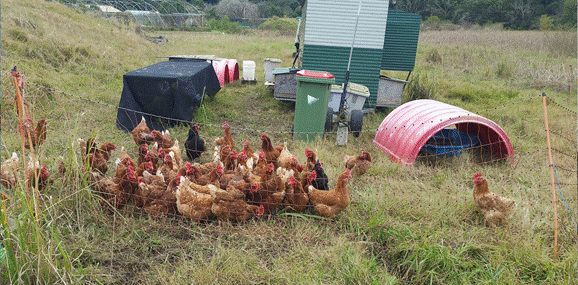
Locavore recipe using bunya nuts & a weed
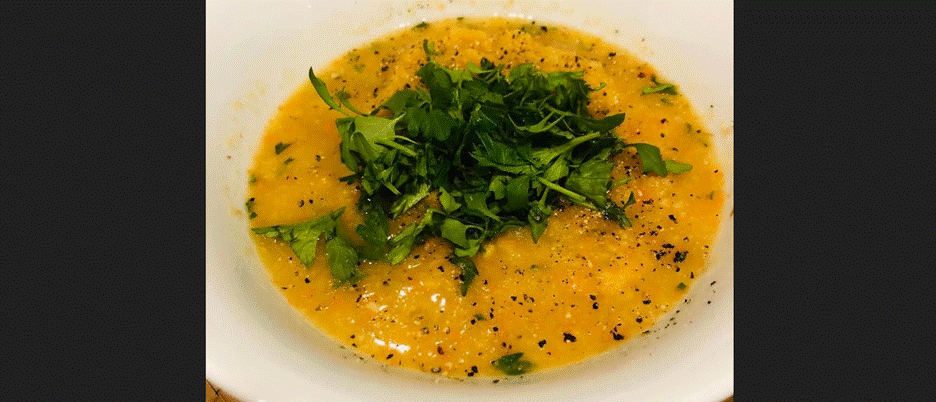
Locavore means to eat food grown locally wherever possible.
This recipe also uses indigenous Bunya nuts. Bunya trees don’t produce nuts every year, but when they do, they produce a lot. It’s best to use the nuts soon after harvest, but they can be frozen. Donna’s recipe below uses frozen bunya nuts that were harvested locally early this year, plus the very bitter citrus fruits from some heritage trees planted when the ecovillage site was a horticultural research station. One of the herbs on top is a local edible weed. Yum!
Bunyas, heritage citrus and bittercress Soup
-Donna Carey
Here is the recipe for a soup that I made earlier this month that included Bunyas, heritage citrus and bittercress.
- Bunya nut, carrot, heritage citrus and ginger soup
- Bunya nuts that I cooked, peeled & froze last season
- White and orange carrots, including a garden gem
- Leek
- Fresh ginger plus a dollop of ginger syrup
- Heritage wild citrus from across our creek
- Cumquat and chilli jam gifted to me by a friend
- Fermented garlic that I made from last year’s crop
- Greens and weeds from my garden and surrounds (Bittercress AKA feral flick weed, kale – Tuscan cavolo nero & red Russian, radicchio, carrot tops, parsley – flat & curly)

Visioning on the Solstice
-Tanya Mottl
Some fun photos of an afternoon of creativity and reflection at the Village Hall.
Shannon Anima brought her experience within a diverse range of communities and her art therapy background for a delightful activity to explore what our dreams for the coming season might be.
Ably assisted by new member Sophie, the room was transformed into a circle with lots of magazines, scissors, glue and textas. We each had a card to reflect on.
It was wonderful that we had a mixed range from 3 up to 80 years!
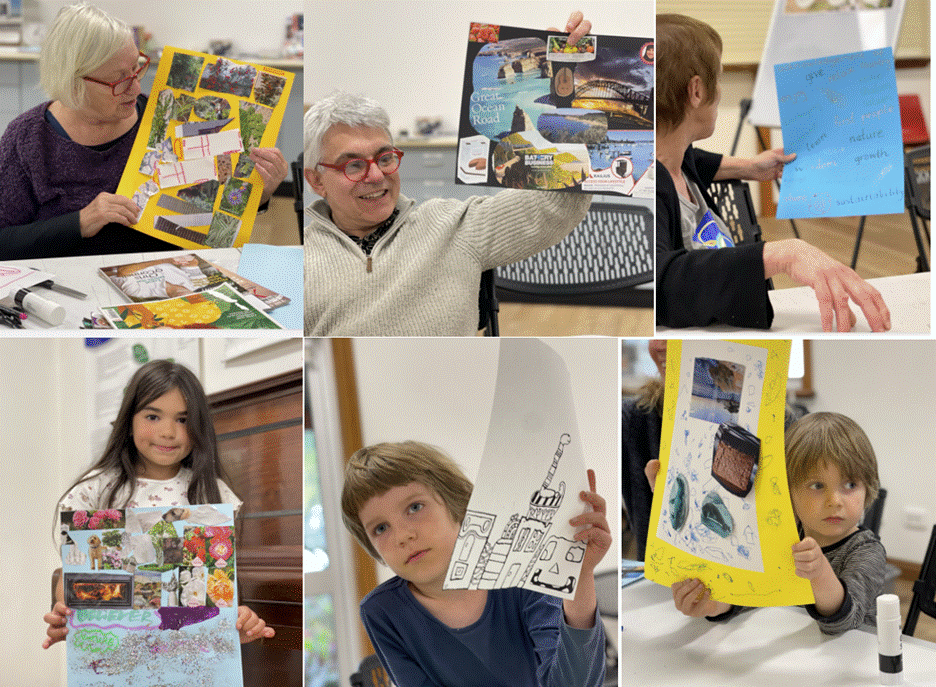
NOBODY did it the same! And everyone’s interpretations were wonderful – from caricatures to garden design, words rather than images – all individual and unique; like us all!
The next Visioning exercise will be for the Spring equinox and the facilitator is Johanne Gallagher, whose perspective comes from her Master of Science in Strategic Leadership towards Sustainability .
Her thesis was looking at ecovillages as part of the social system and what makes them successful or failures.
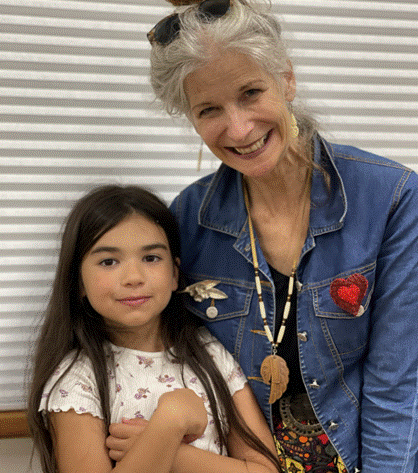
Shannon with her assistant

